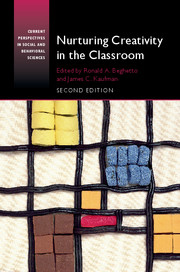Book contents
- Frontmatter
- Dedication
- Contents
- Preface
- Acknowledgments
- PART I VOICES FROM THE FIELD
- 1 Changing the Subject
- 2 Creativity and the Invention Convention
- 3 Creativity and Shifting Roles of an Educational Leader: A Reflection of What Creativity Used to Mean to Me and What It MeansNow
- 4 What I Used to Think about Creativity in Schools
- PART II VOICES FROM THE RESEARCH
- Index
2 - Creativity and the Invention Convention
from PART I - VOICES FROM THE FIELD
Published online by Cambridge University Press: 24 November 2016
- Frontmatter
- Dedication
- Contents
- Preface
- Acknowledgments
- PART I VOICES FROM THE FIELD
- 1 Changing the Subject
- 2 Creativity and the Invention Convention
- 3 Creativity and Shifting Roles of an Educational Leader: A Reflection of What Creativity Used to Mean to Me and What It MeansNow
- 4 What I Used to Think about Creativity in Schools
- PART II VOICES FROM THE RESEARCH
- Index
Summary
I am living my boyhood dream – and no, it's not the one involving Raquel Welch.
When I was 16, like many young people, I wanted to have an impact and to change the world. I became an engineer in order to design and build things that would change the world. But then I became a teacher so that I could educate hundreds of students who would then themselves change the world. Now I am working with the Connecticut Invention Convention where I am supporting hundreds of teachers who are educating thousands of students who will change the world.
I love every day of it.
The Connecticut Invention Convention (CIC) is the largest and oldest continuously operating student invention program in the United States. Last year more than 16,000 students in grades K through 8 from 246 schools across the state experienced this program, which brings creativity and problem solving into the classroom in the form of an invention education curriculum and competition.
When I first started out teaching, it was something of a personal mandate for me. I wanted to be able to take my years of engineering experience and inspire young people toward those same wonders. If there ever was a STEM-focused problem-solving teacher, it was I. In fact, I would not tell my kids I was a teacher because in my heart of hearts I was still an engineer. So I would tell the students that I was hired to be a problem solver. “In the beginning of the year, the School Board gives me a curriculum and a school room of empty heads, and I have until the end of the year to get that knowledge into your heads. The teaching and homework is about me trying to solve the problem of how to get all the cool information into your heads. All those quizzes and tests we take? You think those are for you? No, they're for me – to help me see if I am doing a good job and if I am solving the problem.”
- Type
- Chapter
- Information
- Nurturing Creativity in the Classroom , pp. 6 - 11Publisher: Cambridge University PressPrint publication year: 2016

